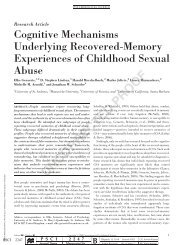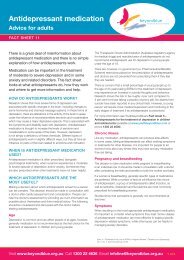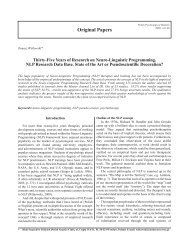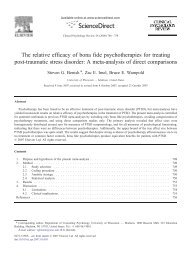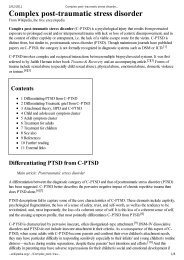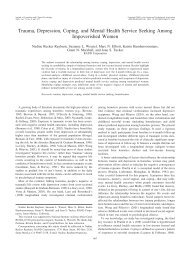The Sociocognitive Model of Dissociative Identity Disorder: A ...
The Sociocognitive Model of Dissociative Identity Disorder: A ...
The Sociocognitive Model of Dissociative Identity Disorder: A ...
You also want an ePaper? Increase the reach of your titles
YUMPU automatically turns print PDFs into web optimized ePapers that Google loves.
50 GLEAVES<br />
summarized in Table 2), all <strong>of</strong> which were based on the use <strong>of</strong><br />
structured interviews, suggest that DID or severe dissociative<br />
symptomatology may be much more common than was once<br />
believed.<br />
In support <strong>of</strong> the sociocognitive model <strong>of</strong> DID, its proponents<br />
argue that the disorder may be iatrogenically created by a select<br />
group <strong>of</strong> therapists. <strong>The</strong> model's proponents cite what they state<br />
to be extreme variation in the prevalence rates for DID found<br />
in different studies as support for this position. For example,<br />
Spanos (1994) compared the finding <strong>of</strong> 3% by Ross, Anderson,<br />
Fleisher, & Norton (1991) with the finding <strong>of</strong> no cases among<br />
89 patients by Merskey (1992; Merskey & Buhrich, 1975).<br />
Although this argument is commonly made, given the nature<br />
<strong>of</strong> these reports, such comparisons cannot be interpreted as<br />
valid. For one reason, if different types <strong>of</strong> clinical samples are<br />
examined (e.g., individuals who have been sexually abused vs.<br />
some other specific Axis I condition), different prevalence rates<br />
may be expected. More important, Spanos (1994) was comparing<br />
systematic evaluation with opinion. Ross, Anderson, et al.<br />
(1991) used a well-validated structured interview (the DDIS)<br />
to systematically evaluate dissociative symptoms. <strong>The</strong>y also<br />
used a second rater who was blind to clinical diagnoses to ensure<br />
a conservative estimate. In addition, all patients with a<br />
prior diagnosis <strong>of</strong> DID were excluded.<br />
Merskey (1992) stated only that he had never seen a case <strong>of</strong><br />
DID. Merskey and Buhrich (1975; which was the study cited<br />
Table 2<br />
Prevalence <strong>of</strong> Patients with <strong>Dissociative</strong> <strong>Disorder</strong> (DD) and<br />
DID Among Clinical and Nonclinical Samples<br />
Study<br />
Ross, Anderson, et al.<br />
(1991)<br />
Saxeetal. (1993)<br />
Von Braunsberg( 1994)<br />
VonBraunsberg(1994)<br />
Latzetal. (1995)<br />
McCallumetal.(l992)<br />
Ross, Kronson, et al.<br />
(1992)<br />
G<strong>of</strong>fetal. (1992)<br />
Anderson etal. (1993)<br />
N<br />
299<br />
110<br />
100<br />
100<br />
175<br />
38<br />
100<br />
100<br />
51<br />
Clinical<br />
Inpatients<br />
Sample<br />
Inpatients<br />
Inpatients (female)<br />
Forensic psychiatric<br />
(male)<br />
State hospital (female)<br />
Eating disorder<br />
Chemically dependent<br />
Obsessive-compulsive<br />
disorder<br />
Sexually abused<br />
Nonclinical<br />
%DD<br />
20.7<br />
13.6<br />
20.0<br />
22.0<br />
31.4<br />
29.0<br />
39.0<br />
10.0<br />
88.0<br />
%DID<br />
3.3<br />
3.6<br />
13.0<br />
17.0<br />
12.0<br />
10.0<br />
14.0<br />
0.0'<br />
54.9<br />
Ross(l991) 454 Community residents 11.2 1.3<br />
Von Braunsberg( 1994) 402 University students 3.5 0.5<br />
Note. Numerals in the DD and DID columns are cases per 100 individuals.<br />
DID = dissociative identity disorder.<br />
a G<strong>of</strong>fet al. noted that there were three patients with dissociative disorder<br />
not otherwise specified who were "similar to MPD [multiple personality<br />
disorder]" (p. 336). A limitation to this study was that the<br />
SC1D-D was administered over the phone, so the raters could not make<br />
behavioral observations. G<strong>of</strong>l'et al. also noted that their assessment process<br />
may not have been sensitive enough to thoroughly evaluate these<br />
cases.<br />
by Spanos) actually made no reference to DID or dissociative<br />
disorders whatsoever, illustrating only that they did not consider<br />
the diagnosis. On the basis <strong>of</strong> Merskey's description <strong>of</strong> his diagnostic<br />
procedure, he appears to have actually avoided inquiring<br />
about symptoms <strong>of</strong> DID out <strong>of</strong> fear that he would create the<br />
disorder. For example, he stated that "one patient dissociated<br />
and talked to herself in a detached fashion. In that instance the<br />
genesis <strong>of</strong> MPD was carefully avoided" (Merskey, 1992, p.<br />
328). Although this statement is somewhat ambiguous, it appears<br />
to imply that Merskey did not ask this person anything<br />
about DID.<br />
Most <strong>of</strong> the data used to argue that DID is rare have been <strong>of</strong><br />
this type. In other similar reports, researchers (e.g., Chod<strong>of</strong>f,<br />
1987; Merskey, 1992) have formerly or informally sampled clinicians<br />
and asked if they had seen a case <strong>of</strong> DID. <strong>The</strong>se data<br />
all suffer from the same limitation: If the disorder is not being<br />
assessed, then one cannot make statements about its prevalence.<br />
Nakdimen (1990) noted that such data do demonstrate that<br />
what is indisputably rare is the clinician who ever considers the<br />
diagnosis <strong>of</strong> DID, and one can only conclude that the researchers<br />
<strong>of</strong> such reports had never seen a case with self-diagnosed or<br />
extremely obvious (atypical) DID. <strong>The</strong> hypothesis that different<br />
prevalence findings are due to the biases <strong>of</strong> the evaluators<br />
could only be tested by comparing findings from studies <strong>of</strong> similar<br />
samples where dissociative symptoms were systematically<br />
evaluated by raters with different preconceptions about DID.<br />
To date, no such study has been conducted (although see Boon<br />
& Draijer, 1993a), who included skeptical raters in their<br />
studies).<br />
A related argument is that, independent <strong>of</strong> prevalence studies,<br />
a large number <strong>of</strong> patients with DID are being reported by<br />
a small number <strong>of</strong> clinicians (Spanos, 1994). Although it is true<br />
that clinicians who specialize in the treatment <strong>of</strong> dissociative<br />
disorders do <strong>of</strong>ten report having worked with a large number <strong>of</strong><br />
patients with DID, this is not unexpected because these clinicians<br />
generally receive referrals already diagnosed as having a<br />
dissociative disorder. Cases in published reports generally come<br />
from a large number <strong>of</strong> different therapists. For example, the<br />
100 patients with DID described by Putnam et al. (1986) were<br />
reported by 92 clinicians; the 71 cases described by Boon &<br />
Draijer (1993a) were referred from 60 clinicians; the 236 cases<br />
described by Ross, Norton, and Wozney (1989) were reported<br />
by 203 different psychiatrists; and the 355 DID cases described<br />
by Schultz et al. (1989) were reported by 355 different clinicians.<br />
Thus, the available published studies do not support the<br />
argument that only a very small number <strong>of</strong> therapists are diagnosing<br />
the majority <strong>of</strong> DID patients.<br />
Cross-cultural evidence. Proponents <strong>of</strong> the sociocognitive<br />
model <strong>of</strong> DID also suggest that DID is a culture-bound phenomenon.<br />
Spanos (1994) listed a number <strong>of</strong> countries in which<br />
he stated that DID is supposedly rare, including France, Great<br />
Britain, USSR, Japan, and Switzerland. <strong>The</strong>se data, however,<br />
suffer from the same limitation as the studies discussed above:<br />
No prevalence studies have been conducted on which to make<br />
statements regarding prevalence. <strong>The</strong> evidence cited by Spanos<br />
was opinions by clinicians or researchers or from surveys <strong>of</strong> psychiatrists<br />
(e.g., Modestin, 1992) who stated that they have never<br />
seen a case <strong>of</strong> DID or know <strong>of</strong> only a small number <strong>of</strong> cases that



